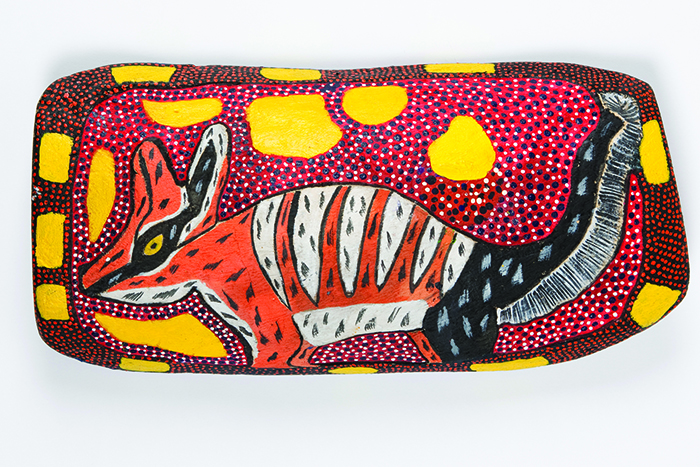The Western Australian Indigenous Art Awards goes above and beyond to promote local Indigenous artists, who work closely with the Art Gallery of WA to produce and display their diverse artworks.
From the Northern Territory to Victoria, Aboriginal and Torres Strait Islander artists are given the opportunity to compete in a number of Indigenous art prizes, worth up to $50,000.
But those entering the Western Australian Indigenous Art Awards have more to gain than just dollars – each finalist is also presented with the chance to collaborate with a professional curator to create, develop and subsequently showcase a repertoire of work that reflects his or her artistic practice.
"Finalists show a body of representative work, rather than one single work," says judge Clotilde Bullen. "Artists can reveal their multidisciplinary practice rather than being forced to choose one work that may only represent one side to them. Once finalists are selected by the judging panel, the curator of the exhibition travels around the continent to speak with the artists, galleries, remote community art centres and owners of the artists' work in order to realise the display."
The artists are then taken to the Art Gallery of WA to participate in the show.
"Certainly there are reputational benefits for the finalists, as the Award carries some prestige, but more than that, I think it's an incredible experience for all working on the Award, including the artists," Clotilde says. "I have had such wonderful feedback regarding the finalists' participation in the show: the camaraderie that develops between the group of finalists and the people who accompany them to Perth to attend and support; the enthusiastic response from the press, from opening night attendees and the public – I hope that the artists leave feeling as if their voice has touched other people."

Untitled (ngurti) by John Prince Siddon, 2014. Synthetic polymer paint, paint marker, felt tip pen and pencil on carved wood, 38x18 cm. Courtesy Mangkaja Arts and Resource Agency.
Fellow judge and Perth Institute of Contemporary Arts director Amy Barrett-Lennard says the awards provide a rare chance for finalists to meet other, likeminded artists, while at the same time creating a place for the public to explore a culture that's constantly changing.
"While I believe it is important for the work of Indigenous Australian artists to be presented alongside that of their non-Indigenous counterparts, I think there is also a place for a particular profiling and analysis of the current trends in Aboriginal and Torres Strait Islander art that can only happen in an event like the WA Indigenous Art Awards," Amy says. "It offers audiences a chance to see Indigenous culture as a living, breathing and very much evolving thing that is so varied across the country, but which nevertheless has some key unifying aspects."
Those aspects can be seen through artworks that focus on issues of identity, notions of authenticity and authority in a postcolonial era, histories of displacement and loss, threats to land and cultural ownership, and relationship to country.

Untitled by Nonggirrnga Marawili, 2015. Natural ochres and earth pigments on board, 244x122 cm. Courtesy the artist and Buku-Larrnggay Mulka Centre.
"The approaches to art-making are so varied from community to community and city to city – that was one of the really startling things about the selection of artists," Amy says.
While a large majority of Indigenous artists have their works recognised through commercial galleries, Amy explains, the representation of Indigenous artists' work in public galleries is not as consistent. The Art Awards is an exception to the rule, being the only ongoing Aboriginal and Torres Strait Islander-specific award in the state.
"The Art Gallery of WA has really strong relationships with arts centres in remote communities across Australia," she says. "They are all invited and very much encouraged to nominate their artists for the awards."

Tjitjiti by Carlene West, 2014. Acrylic on linen, 197x137cm. Courtesy Arthur Roe Collection.
Those nominated come from across generations and geographical locations, and this year include WA finalists Billy Yunkura Atkins, Carlene West, Simon Hogan, Sandra Hill, John Prince Siddon and Eunice Porter, who get to compete for a $10,000 prize, in a field only open to WA artists.
"[The WA prize] has encouraged remote community art centres in Western Australia and their artists to put forward nominations, and it has encouraged independent Western Australian artists to talk to their gallerists or representatives about becoming nominated," Clotilde says. "We have also seen how it has inspired Western Australian Indigenous artists to produce outstanding, innovative work that will rightfully earn them a place as a finalist, and if we can continue to encourage more exciting and creative ways of working, then the Award has done its job, I think."
Western Australian Indigenous Art Awards 2015, Art Gallery of Western Australia, July 4-October 12.